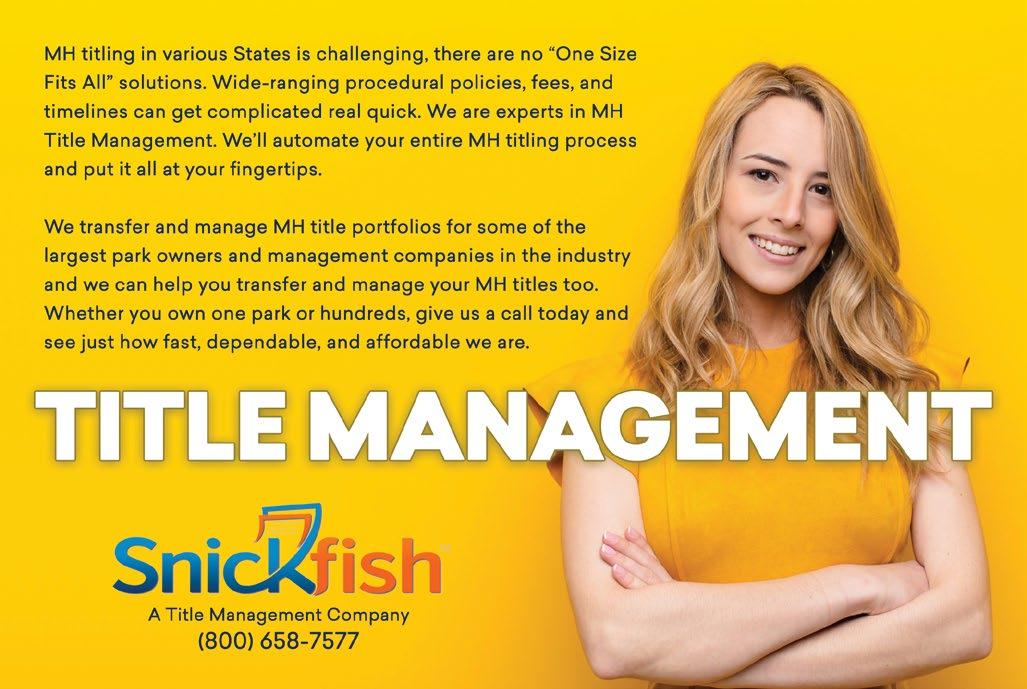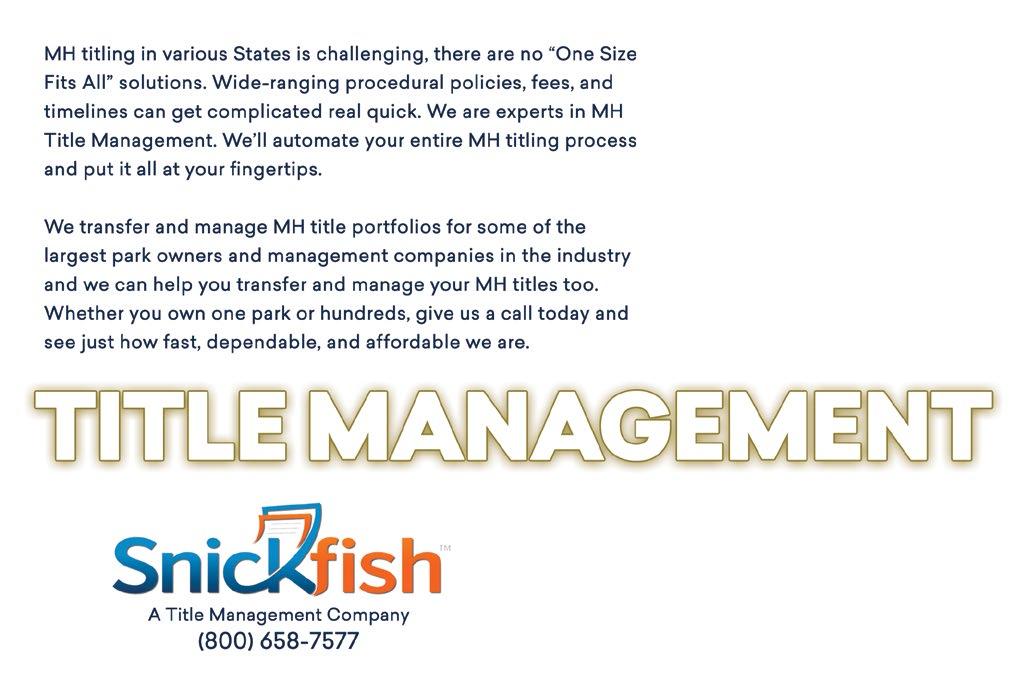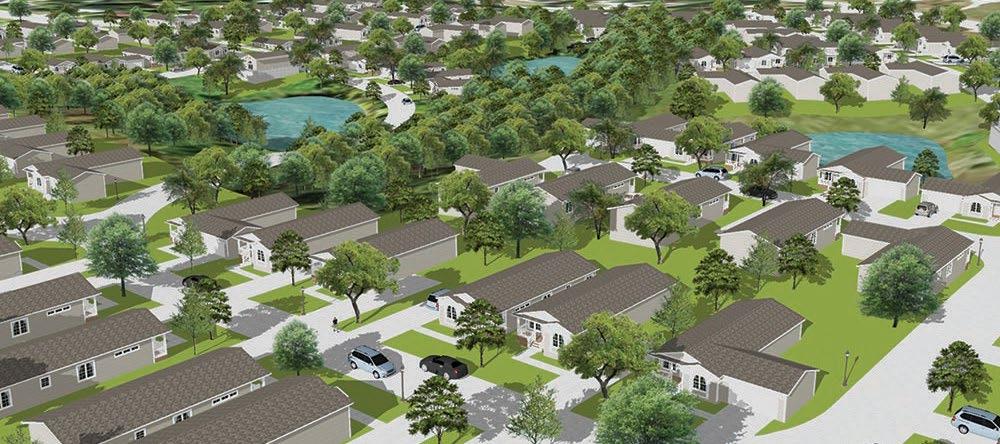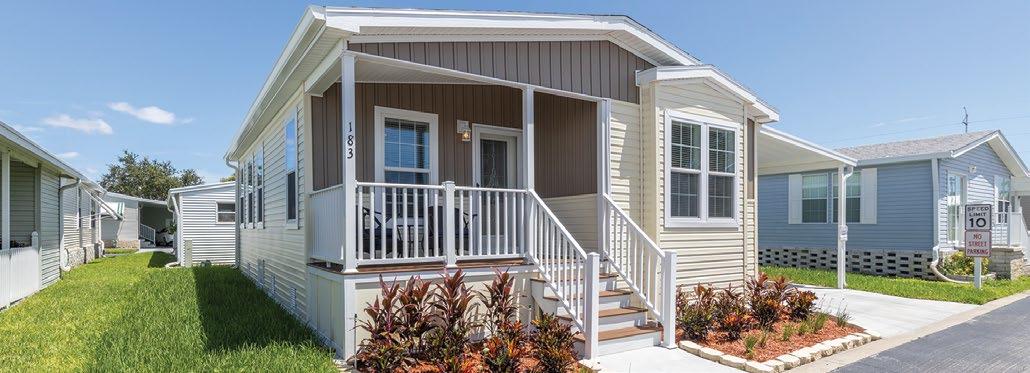
9 minute read
MH Advantage® FAQ with Fannie Mae
from MHInsider™ July/August 2020 - MHInsider 2020 Industry Awards / SECO20 Conference Goes Viral
by MHInsider
MHInsider asked Fannie Mae to work with us on answering some frequently asked questions associated with the MH Advantage® lending program and qualifying homes. From the basics of the program to how appraisal work is managed, Fannie Mae’s Starla Sand, a national evaluation analyst, provided the information for our FAQ on MH Advantage.
» 1. What is MH Advantage®?
MH Advantage® is an innovative new homeownership option that pairs affordable financing with specially designated manufactured housing designed with characteristics typical of site-built homes.
» 2. What are the differences between standard MH and
MH Advantage?
Homes that qualify for MH Advantage financing will be labeled as an MH Advantage home because they have characteristics that homebuyers favor when looking at site-built homes. For instance, an MH Advantage home would have attributes such as a front porch, an attached garage, sidewalks, a permanent foundation with a masonry perimeter, drywall interior, hardwood cabinets, enhanced insulation and Energy Star appliances that other manufactured homes may not have.
» 3. When appraising a property how would an appraiser distinguish between a standard
MH and MH Advantage?
In addition to the HUD data plates and HUD certification labels there is an MH Advantage sticker affixed to the home as well. »
» 4. What is the MH Advantage manufacturer sticker and where can it be found?
An MH Advantage sticker will be affixed to homes designed to meet MH Advantage eligibility criteria, for easy identification by retailers, lenders, and appraisers. The sticker typically is found next to the HUD data plate.
» 5. What is the biggest challenge in appraising MH Advantage eligible homes?
MH advantage is relatively new, so the industry is familiarizing itself with the product, what makes it unique, and what the appraisal requirements are. However, one of the benefits of appraising homes for MH Advantage is that comparable site-built homes can be used to develop the valuation if comps for MH Advantage homes or similar manufactured homes are unavailable.
» 6. What is being done to get information out on how to appraise MH
Advantage homes?
Fannie Mae has implemented several education and training programs for appraisers interested in

working with manufactured housing and MH Advantage. · Appraisers can sign up for Fannie Mae’s Appraiser website; It includes Q&A, newsletters, and appraiser topics. It also allows appraisers to submit a question for Fannie Mae to answer. · Fannie Mae has collaborated with McKissock, the nation’s largest appraiser CE provider, to create Appraising Today’s
Manufactured Homes, a 7-hour continuing education course that explains Fannie Mae’s appraisal policies concerning MH with a deep dive and case studies on MH
Advantage appraising. · Fannie Mae offers training sessions to lenders, AMCs and appraisal groups. · Fannie Mae has a presence in industry events and is offering presentations with Q&A.
» 7. MH Advantage appears to be a crossover between a manufactured home and a site-built home, so what form is it completed on?
And, are manufactured home sales an appraisal requirement?
Yes, that is correct, it is a cross over. Since it is a manufactured home it is completed on the 1004C (manufactured home form). However, unlike a standard MH appraisal, two manufactured home sales are not an appraisal requirement.
» 8. How can an appraiser pick comparable sales when they appraise MH Advantageeligible home?
The known challenge is that there are few or no MH Advantage sales currently available in many locations for sales comparison purposes. Based on our Selling Guide requirements, appraisers must supplement with the best and appropriate sales available in those locations, which may include site-built homes. The goal is to ensure an accurate appraisal that reflects the market value, condition, and marketability of the property.
» 9. What is not permitted to be used as comparable sales? Appraisers are not permitted to create comparable sales by combining a vacant land sale with the contract purchase price of a home.
» 10. Are there appraisal require ments that are specific to
MH Advantage?
Yes, for MH Advantage appraisals, the appraisers are required to provide photos of the data plate, HUD labels, MH Advantage sticker, driveway and sidewalks. For purchase transactions, the appraiser must analyze the sale contract, manufacturer/retailer’s invoice for new manufactured homes, and provide a summary in the appraisal report, and complete the cost approach.
» 11. What are the most common deficiencies with Manufactured Home Appraisals?
Sometimes there is a failure to properly rate the quality of the subject home, particularly in MH Advantage appraisals. As a result,
appraisers that use older, lesser quality manufactured home sales without proper adjustments or a superior quality site-built homes without proper adjustments can result in under- or over-valuations.
» 12. How can appraisers over come this?
The appraiser is responsible for determining if sufficient information exists to value the property. The appraiser should review plans, specs and other documents to understand the exterior/interior features, characteristics, and quality of the home. It is good practice to visit a manufacturer’s website to view photos, videos, or other virtual depictions of the home, or visit a dealer lot or model home.
» 13. What are the MH appraiser qualifications?
To qualify to complete this type of appraisal assignment, an appraiser must possess the knowledge and experience to fully understand the unique construction process of manufactured homes, as well as the manufacturers and federal, state, and local requirements for construction and installation.
» 14. Is MH Advantage found primarily in rural markets or are there subdivisions?
The MH Advantage program and qualifying homes are such a new product that we’re still taking stock in how developers and homeowners are applying the potential for this new type of manufactured housing. However, the program and qualifying homes are designed to blend into existing neighborhoods as much as they’re a fit for rural settings. MHV
Starla Sand is a national review appraiser for the Risk, Eligibility and Valuation team in the Loan Quality Center at Fannie Mae, and she leads the MH/MHA appraisal training courses for appraisers, lenders and real estate professionals. Sand also is active in the affordable housing space working to provide for low- to moderate-income homebuyers. With more than 28 years of experience as an appraiser, national reviewer, realtor, and educator she brings insightful knowledge to share with the real estate industry.


manuals, one on mobile home park operations and another for mobile home retailers. These helpful how-to guides were supplemented in part by Gary W. Pomeroy’s classic “How to Successfully Sell New & Resale Manufactured Homes” published in 1977 and 1980. The irony here is that this Golden West Homes-published case bound text was not only the first MH sales text published, but remains the sole resource 35 years later!
Then followed an era during which freelance consultants shared their knowledge and experience relative to manufactured housing and communities.
Industry Consultants Who Authored Books
First was Craig White, ACM, then of Aristek Corporation in Denver, and later with other firms. His “Management of MH Communities” lesson outlines material and articles published in “Manufactured Housing Dealer” magazine under the auspices of the now-defunct Hudson Institute, which established early protocols for an industry chart of operating accounts for communities. Included were operating expense ratios, all of which materialized in 1992. Craig’s work was followed by Thomas P. Kerr, a California-based consultant. His 1980 “Guide to Mobilehome Parks & Condominiums” explored territory never before considered; condominiumizing of communities. White and Kerr’s published works set the stage for Nevada-based Stephen G. Pappas’ IREM-published “Managing Mobile Home Parks” monograph in 1990, in effect bringing this early period of manufactured housing and communities history to a close.
Next month we’ll explore Part II, and the dozen-plus books published that describe manufactured housing and manufactured home communities between 1990 and today.
Here’s an interesting, albeit unfortunate sidebar, relative to the six just-identified individuals who made and wrote MH and community history between 1955 and 1990. To date, not one of them has been recommended for approval and induction into the RV/MH Heritage Foundation’s prestigious RV/MH Hall of Fame in Elkhart, Ind. That’s right, since the Hall of Fame opened its doors in 1972, more than 400 pioneering men and women of the manufactured housing industry and the land-lease community real estate asset class have received this singular personal honor. However, among them nary an individual who studied and described the unique business models many of us follow to this day. Perhaps there’s a “group solution” to this unintentional oversight a half-century ago.
George Allen has owned and fee-managed land-lease communities since 1978. He’s a former MHI Industry Person of the Year and a member of the RV/MH Hall of Fame. He has been designated a Certified Property Manager-Emeritus and a Manufactured Housing Manager-Master. He’s also a senior consultant and staff writer with EducateMHC. Allen can be reached at (317) 346-7156 and gfa7156@aol.com.
Just because the world may never be the same, doesn’t mean we can’t make it better.

Contact us at innovate@dcwestphal.com or 1-844- 664-6234 to find out how we can help future-proof the design of your next community
Design for a better world.

Photo courtesy of Tharakan Consulting

Tracing Manufactured Housing & Community History Through the Authors
Part I: 1955 – 1990
by George Allen, CPM Emeritus, MHM-Master
L.C. Michelon, a professor at the University of Chicago in 1955, gave us “How to Build & Operate a Mobile Home Park”. In this Mobile Home Manufacturers Association-sanctioned text, the author describes how to develop raw or fallow ground into mobile home parks; separates MH & RV development; and emphasizes the importance of “planning, location & management” as the keys to “park” success.
The next writer on the MH scene is Frederick H. Bair with his co-author Ernest Bartley, both from Florida. Their 150-page book “Mobile Home Parks & Comprehensive Community Planning” book of 1960 was made possible by a grant from the Mobile Home Research Foundation of Chicago. Bair and Bartley tell us in a statement:
“In the five-year period 1954-58, starts were made on 538,000 privately-owned nonfarm dwelling units in multiple-family dwellings, and on 168,000 units in two-family dwellings. In the same period, 480,000 mobile home units were shipped to dealers. Thus, in the most recent five-year span for which figures are available, almost as many dwelling units were added in the form of mobile homes as in multiple-family dwellings, and almost three times as many mobile home units were added as units in two-family dwellings.”
And they provide us a bit of trend information at the time.
“…the movement toward 12 foot wide units may increase consumer acceptance in the same way the move to 10 foot wide units did a few years ago.”
Five years later, F. H. Bair alone followed up with a new book, “Local Regulation of Mobile Home Parks, Travel Trailer Parks, & related-Facilities”.
During the mid-1970s through early ’80s, the Mobile Home Manufacturers Association, and Mobile Home Dealers National Association, headquartered together in Chantilly, Va., supplied guidance through two accounting










